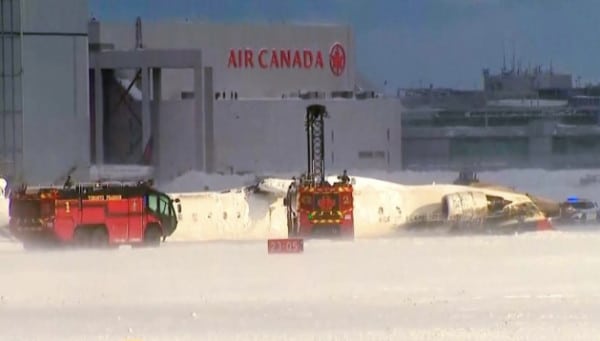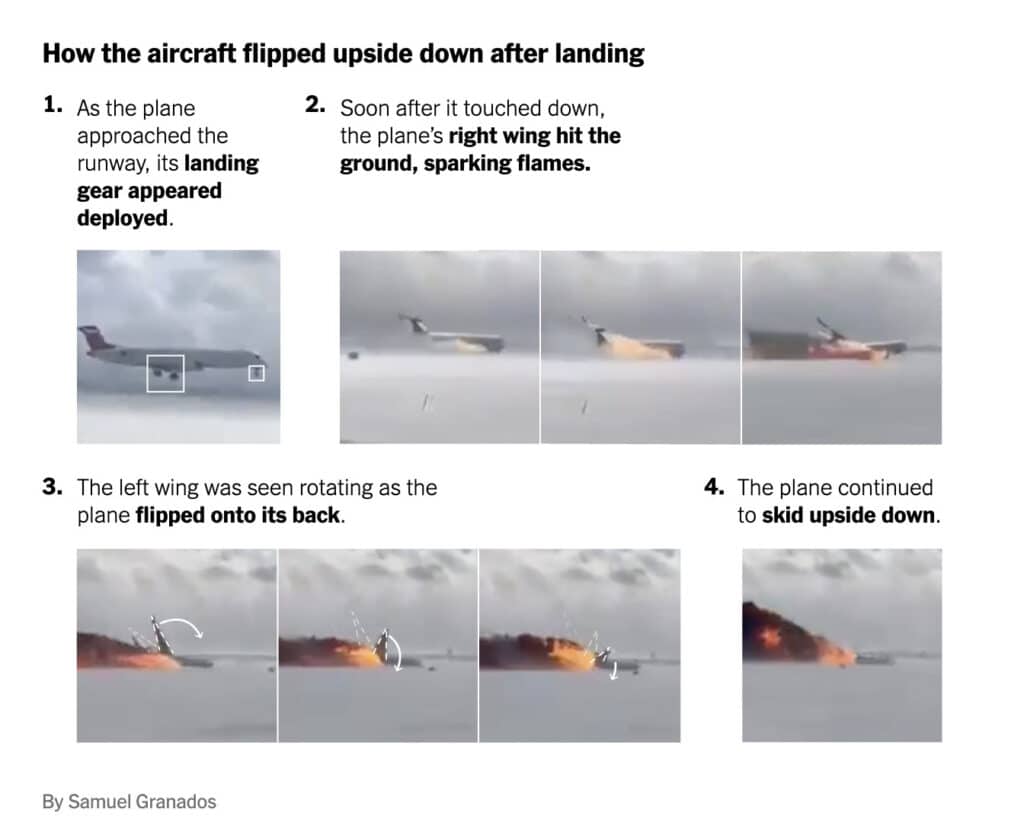
But all 80 people aboard clambered out of the jet coming in from Minneapolis. At least 18 of them suffered injuries, some of them critical but not life-threatening. There were 76 passengers, four crew, and 22 Canadians aboard. People were “hanging like bats,” said one survivor.
The authorities are investigating the cause of the accident, which occurred amid strong winds and drifting snow.
A passenger said the plane skidded when it hit the runway. He saw flames as it hit the ground.
A Tuesday video circulating on social media and verified by The New York Times may offer clues about what caused the plane to tilt to its right before flipping onto its back. The video, taken from a nearby runway, shows the aircraft landing hard on a snow-covered runway and then flipping over on its right side amid black clouds of smoke. The Times has so far been unable to reach the person who took the video.
It is a hard landing. It doesn’t look like he lifted the nose of the plane and came in like a bullet.
A clear visual of the the Delta CRJ900, operated by Endeavor Air as Flight DL4819 from Minneapolis St. Paul, crash-landed at Toronto Pearson International Airport on Monday, flipping onto its side on the snow-covered Runway 24R, but miraculously, all the occupants survived.
— FL360aero (@fl360aero) February 18, 2025
Endeavor Air, a Delta subsidiary that typically operates smaller planes for the airline, operated the model CRJ900 aircraft. They are very DEI-ish.
Gee, with all their emphasis on DEI, you’d think they’d have a perfect landing:
The pinned video on Delta’s TikTok account: pic.twitter.com/leDMlhtAq3
— Libs of TikTok (@libsoftiktok) February 18, 2025

Experienced Pilot Brian Smith
“Fortunately, events like this where the aircraft is turned over are vanishingly rare. They are almost always related to the severity of the impact with the ground and the attitude [the position of wings and nose in relation to the horizon] of the aircraft,” says Smith.
“The aircraft, in this case, does appear to have suffered a very heavy landing, a landing in which the manufacturer’s limit for the rate of descent has been exceeded,” Smith says, admitting that this is speculative while we await more information.
“Usually this is more than about 650 to 700 feet per minute, or a G-force exceeding about 2.6. The result is that the left wing has snapped and ‘folded’ up, immediately followed by an explosion and a large pall of black smoke, which obscures the subsequent overturning moment. The undercarriage appears to have been broken off, at least partially.”
Smith says: “Hard landings are often the result of an unstable approach, which in simple terms means that one or more parameters are outside of acceptable limits: either speed, rate of descent or power setting being the most likely. In the videos I have seen, there also doesn’t seem to be any ‘flare’, the point just above the runway, where the aircraft is pitched up slightly, as the thrust is reduced, to arrest the rate of descent and enable a softer landing.”




A miracle they all survived, much to be happy about.
At first glance? Gross pilot error? The TikTok video makes Delta look like a house of fools.